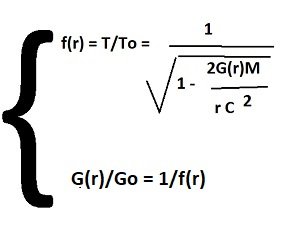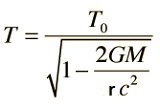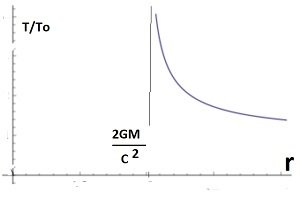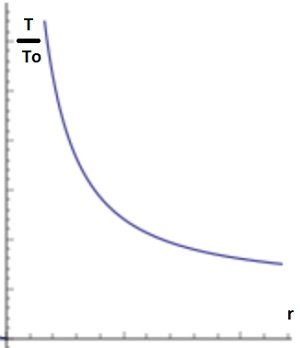

SergUpstart
Senior Members-
Posts
501 -
Joined
-
Last visited
-
Days Won
1
Content Type
Profiles
Forums
Events
Everything posted by SergUpstart
-
This is not about refuting the GRT, but about correcting it. G in the GRT equation must be a variable whose value is inversely proportional to the time dilation. The fact that gravity is a curvature of space-time by the momentum energy tensor, the fact that it propagates in the form of gravitational waves at the speed of light, which is constant, all this is beyond doubt.
-
And what about the reconstruction of pyramid construction technology? Elon Musk the year before last generally said that the pyramids were built by aliens Or reconstruction of bronze melting technology. The problem here is that there are no forests in Egypt, and charcoal is needed for metallurgy.
-
No, wrong. The consequence of this post is that the event horizon should not arise at all. If we plot the time dilation function for the mass of a material point The graph of the function T (r)/To looks like this The graph shows that at r=2GM/c^2, the time dilation becomes infinitely large, i.e. the so-called event horizon takes place. Now we take into account the change in the gravitational constant inversely proportional to the time dilation, for which we solve the following system of equations. The solution of this system of equations Graph of the received function It can be seen from this graph that the time dilation for an external observer becomes infinite only at r=0. Thus, there is no event horizon. There are many massive and supermassive bodies in the universe that are asymptotically similar to black holes, but they should not have an event horizon.
-
Calculating the acceleration of free fall on the surface of the planet is only an intermediate task here. The final task is to calculate the gravitational constant. And in the condition of the problem there are two independent distances, the height of the fall of the apple H and the radius of the planet R. Do you assume that there is such a way to recalculate two independent distances that G will be left behind by a constant? And it should also be borne in mind that the gravitational well is formed not only (or even not so much) by the gravity of the planet, but also by the gravity of the star, galaxy....
-
Here we consider acceleration in the non-relativistic case. The apple is falling at a speed much less than the speed of light. Let's look at the second part of the topic related to the oscillatory circuit. There it is proved that in the reference frame of the remote observer the dielectric constant decreases in proportion to the decrease in the standard length. It is logical to assume that G should change in the same way ( taking into account the fact that the dielectric constant is included in the denominator in Coulomb's law, and G is included in the numerator in Newton's law of gravity )
-
By time slowed you mean it takes longer according to that clock, right? The distant observer's clock runs faster than the one next to the tree. Also, it's not the weaker gravity, it's being higher up in the gravity well that causes time dilation. g could be constant and you would still have this effect. Yes, that's right, by weaker gravity, it meant that the remote observer is higher in the gravity well. But if we substitute time into the equation of motion according to the readings of the remote observer's clock, then the magnitude of the acceleration of gravity g will be different.
-
Let's do a thought experiment. A tree grows on planet X, an apple falls from it from a height H. There is an observer next to the tree, and in his frame of reference, the apple will fall in time Let another observer from outer space also observe the fall of an apple through a telescope. Due to the fact that the second observer is < br /> in a weaker gravity, in its frame of reference, the time of the apple's fall will be slowed down by a factor of k, and the height of H will also be increased by a factor of k. From this it can be seen that in the reference frame of a remote observer, the acceleration of gravity on the surface of planet X should be k times less. This change also corresponds to the dimension of the acceleration of free fall, m/s^2. But on the other hand where M and R are the mass and radius of planet X, respectively. In the reference frame of a remote observer, the radius of planet X will also increase by a factor k, and the acceleration of gravity on the surface of planet X g' will be This shows that in order for the acceleration of free fall on the surface of planet X in sesame starting a remote observer g' would be k times less than it is in the system of reference of the observer insider, requires that the gravitational constant G in the reference frame of an external observer would also k times greater than in the reference system of observer-insider. Otherwise, in the reference frame of the remote observer, the acceleration of gravity g' will not be in k, but in k^2 times less than it is in the frame of reference of the insider observer. This simple thought experiment proves that in the reference frame of a remote observer, the gravitational constant must change back proportional to the change in the distance/time scale. Next, we consider the LC oscillatory circuit. The capacity of the capacitor in the frame of reference of the insider observer is calculated by the formula. First, let's see how the capacitance of the capacitor will change in the reference frame of the remote observer, if we assume that the dielectric constant on changes. In the reference frame of an external observer, the area of the capacitor plates will increase by k^2 times, and the distance between the plates will also increase by k times, thus, the capacitance of the capacitor will increase by k times. Next, let's see how the inductance of the coil will change in the reference system of the remote observer, which is in the reference system of the insider observer it is calculated by the formula. First, let's see how the capacitance of the capacitor will change in the reference frame of the remote observer, if we assume that the dielectric constant on changes. In the reference frame of an external observer, the area of the capacitor plates will increase by k^2 times, and the distance between the plates will also increase by k times, thus, the capacitance of the capacitor will increase by k times. Next, let's see how the inductance of the coil will change in the reference system of the remote observer, which is in the reference system of the insider observer it is calculated by the formula. We see that the oscillation period increases by k times, as it should be. But the dimension of the electric constant F/m, so that in the reference frame of a remote observer, it should decrease by k times, then, in order for the speed of light to remain constant, the magnetic constant must increase by k times. Then, in the reference frame of the remote observer, the capacitance of the capacitor will not change, but the inductance of the coil will increase by k^2 times. Thus, the oscillation period of the oscillating circuit will also increase by k times in this case. To find out which of these two options is correct, we will introduce an active resistance into the oscillatory circuit so that the fluctuations in it become attenuated. Let's see how the resistance value changes when switching to the reference system of a remote observer. Resistance is the ratio the difference of electrical potentials to the current strength in the conductor. The dimension of the electric potential is Joule/Coulomb. The joule does not change when the time/distance scale changes synchronously, and the Сoulomb is not related to the time/distance scales at all, therefore, the difference of electrical potentials in the reference system of the remote observer will be the same as in the reference system an insider's observer. The strength of the electric current in the conductor is equal to the ratio of the charge that has passed through the cross-section of the conductor to the time for which this charge passed. The charge in the reference frame of the external observer will be the same as in the reference frame of the insider observer but the time will increase by k times. Thus, the resistance in the reference frame of the remote observer will be k times greater than in the reference frame of the insider-observer. In order for both the insider observer and the remote observer to see the same picture of damped oscillations on different time scales, it is required that the Q-factor of the oscillatory circuit in the reference systems of both observers would be the same. (Q-factor is a parameter of the oscillatory system that determines the resonance width and characterizes, how many times are the energy reserves in the system greater than the energy losses during the phase change by 1 radian.) In the first variant, when the dielectric and magnetic constants are considered unchanged, in the reference frame of the remote observer, the Q-factor the oscillating circuit will be And in the second variant, when the dielectric and magnetic constants change in different directions by k times, in the reference frame of the remote observer the Q-factor the oscillating circuit will be Thus, this thought experiment with an oscillatory circuit shows that in the reference frame of a remote observer, the dielectric and magnetic constants must change in different directions in accordance with the change in the time/distance scale. Then it is not difficult to show that the Planck constant will also change in the reference frame of the remote observer, since it is equal to For those who still do not believe that the numerical value of the gravitational constant in the reference frame of a remote observer changes back in proportion to the change in the time/distance scale, I propose to solve the following problem. On a planet with a mass of 5.97*10 ^ 24 kg, a radius of 6317000 m, an apple falls from a tree from a height of 5 m in 1 second, calculate the value of the gravitational constant G. And then calculate the value of the gravitational constant G' in the reference frame of the remote observer, in which the apple falls for 1.1 seconds from a height of 5.5 m and the radius of the planet is 6948700, respectively, and compare the obtained values of G and G'.
-
To do this, the size of the accelerometer must be negligible compared to the curvature of ST. The accelerometer in the form of comet Shoemaker-Levy in July 1994 perfectly "discovered" the gravity of Jupiter.
-
However, after 2008, the European Union had its own debt crisis, related specifically to the government debts of the PIGS countries
-
If you have a debt of $ 1,000 at a rate of 1%, then you will have to spend $ 10 a year on debt servicing, and if the rate increases to 2% , then you will need $ 20 for debt servicing. And there is another problem with debts. If the population is heavily credited, then it can no longer take out loans for the purchase of goods, including electronics, cars and real estate. This should inevitably cause a decline in demand, which can develop into a sales crisis.
-
The financial system is gradually losing its stability. The Fed already does not have the opportunity to significantly raise rates, since this will cause problems with debt servicing.
-
I don't see anything good in this. Something must eventually happen, either hyperinflation or a parade of defaults. The question is when. How long can an atom be in an excited state? How long can water vapor be in a supercooled state?
-
We should talk not only about the American, but in general about the world economy. Global debt could reach $300 trillion by the end of the year. https://psm7.com/money/mirovoj-dolg-mozhet-dostignut-otmetki-v-300-trln-uzhe-v-etom-godu.html
-
strictly speaking, the motion in a circular orbit is determined by the sum of the masses of the planets and the central body The speed (or the magnitude of velocity) relative to the central object is constant:[1]:30 {\displaystyle v={\sqrt {GM\! \over {r}}}={\sqrt {\mu \over {r}}}} where: {\displaystyle G}, is the gravitational constant {\displaystyle M}, is the mass of both orbiting bodies {\displaystyle (M_{1}+M_{2})}, although in common practice, if the greater mass is significantly larger, the lesser mass is often neglected, with minimal change in the result. {\displaystyle \mu =GM}, is the standard gravitational parameter. https://en.wikipedia.org/wiki/Circular_orbit But in most cases, the masses of the planets can be ignored. Perhaps the Earth too To this effect, you can also add the influence of tides. It is not a solid body. Due to the tides, it gradually loses the angular momentum, which should be compensated by the removal of the planets. In addition, the rotation of the planets around their axis is gradually synchronized with their rotation around the Sun, and this effect also leads to an increase in the radii of the orbits of the planets. But the impact of these effects is also insignificant.
-
Well, then it follows simply from the definition of the gravitational radius R=GM/c^2 that the ratio of the gravitational radius of the universe to the gravitational radius of an electron is equal to the ratio of their masses. But the mass of the electron is about 10^-30 kg, and the mass of the Universe is about 10^56 kg. So if we use gravitational radii, their ratio will be different. Not so, the field strength is the gradient from the potential with a minus sign. And the force is the field strength multiplied by the mass of the test body ( if we are talking about the gravitational force in the Newton paradigm) or by the test charge (if we are talking about the electrostatic force).
-
The electron does not have a certain radius and certain coordinates. An electron is not a ball. This follows from the Heisenberg uncertainty principle. Maybe you meant the radius of the orbit of an electron in a hydrogen atom??? But the electron does not have a clear orbit in the atom, at present physicists are talking not about orbits, but about orbitals.





